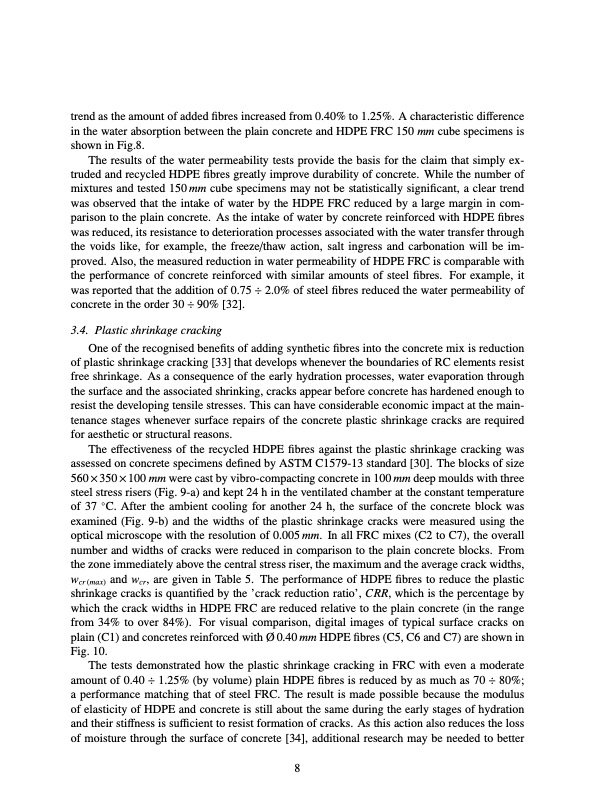
PDF Publication Title:
Text from PDF Page: 009
trend as the amount of added fibres increased from 0.40% to 1.25%. A characteristic difference in the water absorption between the plain concrete and HDPE FRC 150 mm cube specimens is shown in Fig.8. The results of the water permeability tests provide the basis for the claim that simply ex- truded and recycled HDPE fibres greatly improve durability of concrete. While the number of mixtures and tested 150 mm cube specimens may not be statistically significant, a clear trend was observed that the intake of water by the HDPE FRC reduced by a large margin in com- parison to the plain concrete. As the intake of water by concrete reinforced with HDPE fibres was reduced, its resistance to deterioration processes associated with the water transfer through the voids like, for example, the freeze/thaw action, salt ingress and carbonation will be im- proved. Also, the measured reduction in water permeability of HDPE FRC is comparable with the performance of concrete reinforced with similar amounts of steel fibres. For example, it was reported that the addition of 0.75 ÷ 2.0% of steel fibres reduced the water permeability of concrete in the order 30 ÷ 90% [32]. 3.4. Plastic shrinkage cracking One of the recognised benefits of adding synthetic fibres into the concrete mix is reduction of plastic shrinkage cracking [33] that develops whenever the boundaries of RC elements resist free shrinkage. As a consequence of the early hydration processes, water evaporation through the surface and the associated shrinking, cracks appear before concrete has hardened enough to resist the developing tensile stresses. This can have considerable economic impact at the main- tenance stages whenever surface repairs of the concrete plastic shrinkage cracks are required for aesthetic or structural reasons. The effectiveness of the recycled HDPE fibres against the plastic shrinkage cracking was assessed on concrete specimens defined by ASTM C1579-13 standard [30]. The blocks of size 560 × 350 × 100 mm were cast by vibro-compacting concrete in 100 mm deep moulds with three steel stress risers (Fig. 9-a) and kept 24 h in the ventilated chamber at the constant temperature of 37 ◦C. After the ambient cooling for another 24 h, the surface of the concrete block was examined (Fig. 9-b) and the widths of the plastic shrinkage cracks were measured using the optical microscope with the resolution of 0.005 mm. In all FRC mixes (C2 to C7), the overall number and widths of cracks were reduced in comparison to the plain concrete blocks. From the zone immediately above the central stress riser, the maximum and the average crack widths, wcr (max) and wcr, are given in Table 5. The performance of HDPE fibres to reduce the plastic shrinkage cracks is quantified by the ’crack reduction ratio’, CRR, which is the percentage by which the crack widths in HDPE FRC are reduced relative to the plain concrete (in the range from 34% to over 84%). For visual comparison, digital images of typical surface cracks on plain (C1) and concretes reinforced with Ø 0.40 mm HDPE fibres (C5, C6 and C7) are shown in Fig. 10. The tests demonstrated how the plastic shrinkage cracking in FRC with even a moderate amount of 0.40 ÷ 1.25% (by volume) plain HDPE fibres is reduced by as much as 70 ÷ 80%; a performance matching that of steel FRC. The result is made possible because the modulus of elasticity of HDPE and concrete is still about the same during the early stages of hydration and their stiffness is sufficient to resist formation of cracks. As this action also reduces the loss of moisture through the surface of concrete [34], additional research may be needed to better 8PDF Image | Mechanical properties of concrete reinforced with recycled HDPE

PDF Search Title:
Mechanical properties of concrete reinforced with recycled HDPEOriginal File Name Searched:
concrete-reinforced-plastics.pdfDIY PDF Search: Google It | Yahoo | Bing
Development of a solar powered Electric Ship The Electricship website originally started off as a project to develop a comprehensive renewable, affordable, modular electric ship... More Info
Modular Boat Hull Composite The case for a unsinkable, modular composite hybrid boat hull... More Info
MS Burgenstock Hybrid Electric Catamaran Lake Lucerne Unique shuttle servicing Lucerne to the Burgenstock Resort... More Info
Ground Power Unit GPU Powered by Lithium Ion Batteries The goal of the Ground Power Unit is to provide a readily accessible, modular, ready-to-power solution for remote power... More Info
| CONTACT TEL: 608-238-6001 Email: greg@electricship.com | RSS | AMP |